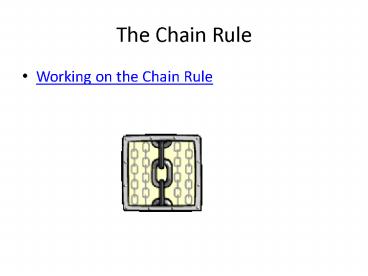The Chain Rule - PowerPoint PPT Presentation
1 / 14
Title:
The Chain Rule
Description:
Why use the chain rule? The previous rules work well to take derivatives of functions such as. How do you best find a derivative of an equation such as – PowerPoint PPT presentation
Number of Views:210
Avg rating:3.0/5.0
Title: The Chain Rule
1
The Chain Rule
- Working on the Chain Rule
2
Review of Derivative Rules
- Using Limits
3
Power Rule
- If f(x)
4
Product Rule
5
Quotient Rule
6
Why use the chain rule?
- The previous rules work well to take derivatives
of functions such as - How do you best find a derivative of an equation
such as
7
The Chain Rule
- The chain rule is used to calculate derivatives
of composite functions, such as f(g(x)). - Ex Let f(x) and
- Therefore, f(g(x))
- Obviously, it would be difficult to expand the
above function. The best way to calculate the
derivative is by use of the chain rule.
8
Chain Rule (cont)
- The derivative of a composite function, f(g)x)),
is found by multiplying the derivative of f(g(x))
by the derivative of g(x). - Or, f(g(x))(g(x))
- In our example, , we obtain
- This is the general power rule of the chain rule
9
Other applications of the chain rule
- To find f(x) when f(x)sin , f(x)(cos
)(2x) - To find f(x) when f(x) rewrite
the equation as - Then, use the general power rule of the chain
rule to obtain
10
Trig and the Chain Rule
- Let f(x)sin u. f(x)(cos u)u
- Ex f(x)sin2x, f(x)cos2x(2)2cos2x
- Find the following derivatives
- A. f(x)cos(x-1)
- B. f(x)cos(2x)
- C. f(x)sin( )
11
- A. f(x) cos(x-1) f(x) -sin(x-1)
- B. f(x) cos(2x) f(x) -2sin(2x)
- C. f(x) sin(2 ) f(x) 4xcos(2 )
12
Combining Chain Rule
- Let f(x)sin(2x)cos(2x). Find f(x)
13
Combine product rule and chain rule
(2x)
(2x)
- Let h(x)sin(2x)cos(2x). Find h(x)
- From product rule, d/dx f(x)g(x)
- f(x)g(x) f(x)g(x)
- From above, if f(x)sin(2x) and g(x)cos(2x),
then f(x)2cos(2x) and g(x)-2sin(2x) - Therefore, h(x)(2cos(2x))(cos(2x))
(sin(2x))(-2sin(2x)) (2x) (2x)
14
Combine quotient rule and chain rule































